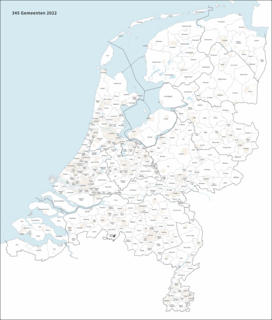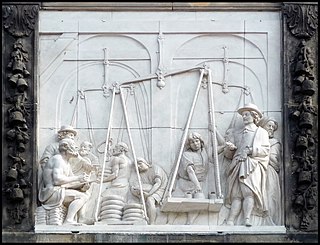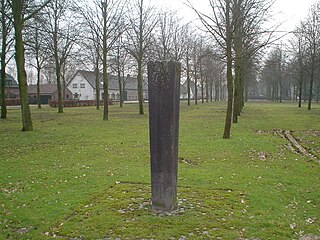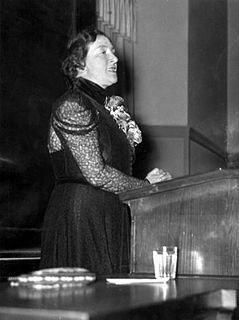
As of 24 March 2022, there are 344 municipalities and three special municipalities in the Netherlands. The latter is the status of three of the six island territories that make up the Dutch Caribbean. Municipalities are the second-level administrative division, or public bodies, in the Netherlands and are subdivisions of their respective provinces. Their duties are delegated to them by the central government and they are ruled by a municipal council that is elected every four years. Municipal mergers have reduced the total number of municipalities by two-thirds since the first official boundaries were created in the mid 19th century. Municipalities themselves are informally subdivided into districts and neighbourhoods for administrative and statistical purposes.

Susteren Abbey is a former Benedictine abbey at Susteren near Roermond, in the Dutch province of Limburg, founded in the 8th century. The former abbey church is now St. Amelberga's Basilica.

The Dutch units of measurement used today are those of the metric system. Before the 19th century, a wide variety of different weights and measures were used by the various Dutch towns and provinces. Despite the country's small size, there was a lack of uniformity. During the Dutch Golden Age, these weights and measures accompanied the Dutch to the farthest corners of their colonial empire, including South Africa, New Amsterdam and the Dutch East Indies. Units of weight included the pond, ons and last. There was also an apothecaries' system of weights. The mijl and roede were measurements of distance. Smaller distances were measured in units based on parts of the body – the el, the voet, the palm and the duim. Area was measured by the morgen, hont, roede and voet. Units of volume included the okshoofd, aam, anker, stoop, and mingel. At the start of the 19th century the Dutch adopted a unified metric system, but it was based on a modified version of the metric system, different from the system used today. In 1869, this was realigned with the international metric system. These old units of measurement have disappeared, but they remain a colourful legacy of the Netherlands' maritime and commercial importance and survive today in a number of Dutch sayings and expressions.

Herman Philipse is a professor of philosophy at Utrecht University in the Netherlands. Philipse taught at Leiden University from 1986 until 2003 where he obtained his doctorate in 1983.

The Free Belgian forces were soldiers from Belgium and its colonies who fought as part of the Allied armies during World War II, after the official Belgian surrender to Nazi Germany. It is distinct from the Belgian Resistance which existed in German-occupied Belgium.

Bavel is a village in the southern Netherlands. It is located in the Dutch province of North Brabant, largely within the municipality of Breda with some rural areas in the municipality of Alphen-Chaam.

Heikant is a neighbourhood in the municipality of Veldhoven, in the Dutch province of North Brabant. With a population of over 6700 inhabitants, it is the largest neighbourhood in Veldhoven. Heikant contains a small shopping centre and a church. The Sint-Maartenchurch was built in 1990.
Dudo of Laurenburg was probably Count of Laurenburg and is considered the founder of the House of Nassau. The House of Nassau would become one of the reigning families in Germany, from which are descended through females the present-day royals of the Netherlands and Luxembourg, while officially belonging to this House.

Schoot is a hamlet in the municipality of Veldhoven in the province of North Brabant, the Netherlands. The hamlet is located on a street with the same name. This street is a side street of the Knegselseweg, the road connecting Veldhoven with the village Knegsel. East of Schoot lies the residential area Pegbroeken. West of Schoot flows the small stream the Poelenloop and lies the forest area Oeyenbos.

Heers is a hamlet in the south of the municipality of Veldhoven in the province of North Brabant, the Netherlands. Most of the buildings are concentrated around a town square with trees. At this town square is a chapel from 1990 located. There is also a monument, erected in 1966 for the local agricultural consolidation project. Heers has a long history. The hamlet is mentioned in books from the Middle Ages. Also, archaeological artefacts from the Bronze Age and the Roman Empire have been unearthed near the hamlet.

Christianus Petrus Eliza Robidé van der Aa was a Dutch jurist and author. He was the son of Pierre Jean Baptiste Charles van der Aa.
Zittard is a hamlet in the municipality of Veldhoven in the province of North Brabant, the Netherlands. The hamlet is located on a road with the same name and consists mostly of farms. As of 2008, Zittard has a population of 160 people.

Zandoerle, in local tongue known as Zandoers, is a hamlet in the municipality of Veldhoven in the province of North Brabant, the Netherlands. The hamlet has a population of 120 people, as measured on the first of January 2008. The hamlet is located between the villages Oerle and Knegsel. Zandoerle can be seen as one of the two centres within the village of Oerle. The other centre is often referred to as Kerkoerle . Zandoerle has great cultural and historical value due to its characteristic village green and monumental farms.

Elizabeth (Beb) Vuyk was a Dutch writer of Indo (Eurasian) descent. Her Indo father was born in the Dutch East Indies and had a mother from Madura, but was ‘repatriated’ to the Netherlands on a very young age. She married into a typically Calvinist Dutch family and lived in the port city of Rotterdam. Vuyk grew up in the Netherlands and went to her father’s land of birth in 1929 at the age of 24. 3 years later she married Fernand de Willigen, a native born Indo that worked in the oil and tea plantations throughout the Indies. They had 2 sons, both born in the Dutch East Indies.
The Royal Academy of Fine Arts of Ghent, is one of the oldest art schools in Belgium. It is now part of the Hogeschool Gent.
Nouchka van Brakel is a Dutch film director known for her 1982 movie Van de koele meren des doods. That movie, and A Woman Like Eve (1979), established her as an important Dutch feminist film director. Van Brakel said that her ambition is to make movies about women who want to change their lives and their societies.
The Battle of Kollum was a military engagement that took place on 16 July 1581 during the Eighty Years' War and the Anglo–Spanish War. The battle was fought between an English and Dutch force under John Norreys and Diederik Sonoy respectively, and a Spanish force under George van Lalaing, the Count of Rennenberg. The Dutch and English were victorious, and as a result of the defeat Rennenberg, already ill, died two days later.

Joost Berman was a Dutch lawyer, judge, politician, poet, nonfiction writer, and editor.

Johanna van Ammers-Küller was a Dutch writer. She was one of the most successful European female writers in the interwar period, though her reputation suffered as a result of her collaboration during World War II.

The Capture of Delfzijl took place during the Eighty Years' War and the Anglo–Spanish War by a Dutch and English army led by Maurice of Orange. The siege commenced on 26 June and lasted until the Spanish troops surrendered the city of Delfzijl on 2 July 1591.















